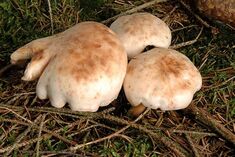Biology:Rhodocollybia maculata
| Rhodocollybia maculata | |
|---|---|

| |
| Scientific classification | |
| Kingdom: | |
| Division: | |
| Class: | |
| Subclass: | Hymenomycetes
|
| Order: | |
| Family: | |
| Genus: | |
| Species: | R. maculata
|
| Binomial name | |
| Rhodocollybia maculata (Alb. & Schwein.: Fr.) Singer[1]
| |
| Synonyms | |
|
Collybia maculata | |
| Rhodocollybia maculata | |
|---|---|
| Mycological characteristics | |
| gills on hymenium | |
| cap is convex or flat | |
| hymenium is adnexed | |
| stipe is bare | |
| spore print is pink to cream | |
| ecology is saprotrophic | |
| edibility: edible, but unpalatable | |
Rhodocollybia maculata, commonly known as the spotted toughshank, is a species of basidiomycete fungus in the family Marasmiaceae.[2][3] It often appears in decomposing conifer duff.[4] R. maculata is a source of collybolide, a sesquiterpenoid containing a furyl-ẟ-lactone motif reminiscent of salvinorin A.[5]
Description
The cap is cream-colored with red-brown spots. The edge remains inrolled for an extended period of time. The whitish gills are crowded, becoming spotted in age. The similarly colored stipe is long, tough, hollow, and tapered downwards.[4]
A variety known as scorzonerea is characterized by yellowish color of its gills, and sometimes the stipe.[4]
Edibility
Though non-toxic,[6] this species is considered inedible due to its toughness and unpalatability;[7] it is typically bitter.[3]
Kappa-opioid receptor agonism
In 2022, Shevick et al. completed the first enantioselective total synthesis of collybolide and profiled the activity of synthetic collybolide at the KOR. Despite previous findings by Gupta et al., these assays showed that neither enantiomer of collybolide had KOR activity.[8] The synthetic sample was identical to natural collybolide isolated from R. maculata. Assays of crude R. maculata extracts by other groups additionally showed no KOR activity.[8][Note 1] These assays of synthetic and natural samples contradict the findings of Gupta et al., and suggest that collybolide and the other constituents of R. maculata have no activity at KOR.
Gallery
Notes
- ↑ See page 150 of the Supporting Information of Shevick et al. for reports on the kappa-opioid receptor assays with crude R. maculata extracts.
References
- ↑ "Rhodocollybia maculata (Alb. & Schwein.: Fr.) Singer". Arizona State University. http://www.public.asu.edu/~stbates/azfungi/rhodocollybia_maculata.html.
- ↑ "Rhodocollybia maculata". MushroomExpert.Com. March 2018. http://www.mushroomexpert.com/rhodocollybia_maculata.html.
- ↑ 3.0 3.1 "Rhodocollybia maculata". The Fungi of California. http://www.mykoweb.com/CAF/species/Rhodocollybia_maculata.html.
- ↑ 4.0 4.1 4.2 Mushrooms of the Pacific Northwest. Timber Press Field Guides. Portland, OR: Timber Press. 2009. pp. 120. ISBN 978-0-88192-935-5. https://books.google.com/books?id=WevHvt6Tr8kC.
- ↑ "Isolement et analyse structurale du collybolide, nouveau sesquiterpene extrait de Collybia maculata alb. et sch. ex fries (basidiomycetes)" (in fr). Tetrahedron 30 (11): 1327–1336. 1974-01-01. doi:10.1016/S0040-4020(01)97243-6. ISSN 0040-4020.
- ↑ North American Mushrooms: A Field Guide to Edible and Inedible Fungi. Guilford, CN: FalconGuide. 2006. pp. 176. ISBN 978-0-7627-3109-1.
- ↑ Mushrooms and Other Fungi of North America. Buffalo, NY: Firefly Books. 2010. p. 73. ISBN 978-1-55407-651-2. https://archive.org/details/mushroomsotherfu0000phil.
- ↑ 8.0 8.1 "Asymmetric Syntheses of (+)- and (-)-Collybolide Enable Reevaluation of kappa-Opioid Receptor Agonism". ACS Central Science 8 (7): 948–954. July 2022. doi:10.1021/acscentsci.2c00442. PMID 35912357.
External links
Wikidata ☰ Q2645787 entry
 |




